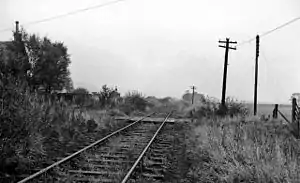Bardowie railway station
Bardowie railway station was opened in 1905 on the Kelvin Valley Railway, later than most of the other stations which had opened with the line itself in 1879. It served the hamlet of Bardowie and the coal mining area, farms, etc. in East Dunbartonshire until 1931 for passengers[1][3] and to freight on 31/7/61.[4]
Bardowie | |
|---|---|
 Site of Bardowie railway station | |
| Location | East Dunbartonshire Scotland |
| Grid reference | NS586730 |
| Platforms | 1 |
| Other information | |
| Status | Disused |
| History | |
| Pre-grouping | North British Railway |
| Post-grouping | London and North Eastern Railway |
| Key dates | |
| 1 June 1905[1] | Station opens |
| 20 July 1931[1] | Station closed[2][3] |
| 31 July 1961 | Line closed to freight |
History

Opened by the North British Railway, it became part of the London and North Eastern Railway during the Grouping of 1923. The line passed to the Scottish Region of British Railways upon nationalisation. Another source gives the opening date as 1905. Bardowie had coal mining waste tips or bings lying to the north of the station. The line remained open to passengers until 1951. In 1959 the line east of Torrance closed. 1961 was the closure date for goods and mineral freight traffic.[4]
It was intended to build around 500 houses in the locality as indicated by the functionally oversized width of Station Road and the orientation of ‘Beechwood’ house on Balmore Road and 1 Station Road at the proposed main entrance to the estate. A large and actively used mining waste disposal bing detracted from the rural setting and the housing that the station was built to serve were never built explaining the early 1931 closure date of Bardowie station.[1][5] Bardowie Loch and castle lie nearby.
Closure of the Kelvin Valley line to passengers was on 20/7/51, but it remained as a through route until 1956; Goods traffic ceased on 1/5/52.[4] The track was still in situ in 1961.[6]
Infrastructure
The single platform and station building with its ticket office, waiting room, canopy, etc. stood on the northern side of this single track line with sidings and cross over sidings on the northern side serving the waste disposal areas on either side of Station Road, etc. A weighing machine house and a stationmaster's house were present. A signal box is shown at the eastern end of the station.[7][8] The main station building stood at the eastern end of the platform. The 1957 OS map shows a passing loop just to the east of the old station on the single track line with all the trackwork otherwise lifted from the spoil bings, etc.[9]
| Preceding station | Historical railways | Following station | ||
|---|---|---|---|---|
| Balmore | North British Railway Kelvin Valley Railway |
Summerston | ||
The site today
The stationmaster's house survives as a private dwelling however the station and a mound represents the old platform site.[4]
References
Notes
- NBR Research Group list of stations
- Butt 1995, p. 27.
- Wignal (1983), Page 4
- Ewan Crawford; John Furnevel; Contributors. "RAILSCOT | Bardowie". railscot.co.uk. Retrieved 22 August 2019.
- "East Dunbartonshire Council | Welcome to East Dunbartonshire Council". eastdunbarton.gov.uk. Retrieved 22 August 2019.
- "Site of Bardowie Station (C) Ben Brooksbank :: Geograph Britain and Ireland". geograph.org.uk. Retrieved 22 August 2019.
- Signalling Record Society - 50 Years RailRef Line Codes NB
- "View: Dumbartonshire nXXIV.6 (Baldernock; Cadder; New Kilpatrick) Publication date: 1918. Revised: 1914 - Ordnance Survey 25 inch 2nd and later editions, Scotland, 1892-1949". maps.nls.uk. Retrieved 22 August 2019.
- NS57SE - A (includes: Baldernock; Cadder; Glasgow; New Kilpatrick) Surveyed / Revised: Pre-1930 to 1957
Sources
- Butt, R. V. J. (1995). The Directory of Railway Stations: details every public and private passenger station, halt, platform and stopping place, past and present (1st ed.). Sparkford: Patrick Stephens Ltd. ISBN 978-1-85260-508-7. OCLC 60251199.
- Wignall, C.J. (1983). Complete British Railways Maps and Gazetteer From 1830-1981. Oxford : Oxford Publishing Co. ISBN 0-86093-162-5.


